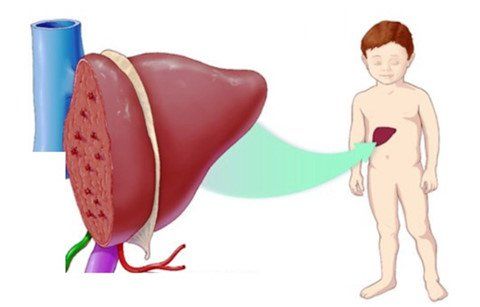This is an automatically translated article.
Posted by Master, Doctor Lam Thi Kim Chi - Department of Diagnostic Imaging - Vinmec Danang International HospitalCongenital biliary atresia is a rare but dangerous disease that, if not treated promptly, can lead to complications of cirrhosis - biliary tract. Early diagnosis of biliary atresia can contribute to treatment orientation, improve clinical symptoms, and reduce the risk of recurrence. Ultrasound is the first diagnostic imaging tool because it is safe, non-radioactive, and can be used to monitor progress before and after surgery.
1. Outline of congenital biliary atresia
Congenital biliary atresia is a rare disease characterized by disruption or deficiency of the extrahepatic biliary system. The incidence is relatively low, common in Asian countries, about 1.4/1 - 1.7/1Currently, the cause of congenital biliary atresia is still unknown. However, the risk of disease will increase in some groups of factors as follows:
Abnormalities in pregnancy: Toxicosis, infection, viral infection...; Environmental factors; Abnormalities of bile metabolism; Abnormal common biliary-pancreatic canal; Race: Asians have a higher incidence; Gender: Female is more common than male; Family history.
2. Clinical features of congenital biliary atresia
Usually found in term neonates between 1st and 6th week postpartum; Jaundice, yellow eyes, dark urine: Nonspecific jaundice for congenital biliary atresia is only a warning value for screening; Discoloration of stool: This is an important symptom in the diagnosis and evaluation of the effectiveness of early surgery and subsequent follow-up; Hepatomegaly in early disease: Splenomegaly suggests advanced cirrhosis and portal hypertension; Late symptoms: Peritoneal cavity fluid, collateral circulation, edema...; Malnutrition, anemia, growth retardation. Most babies still grow to a normal weight and body in the first few months; Subcutaneous hemorrhage, intracranial hemorrhage due to vitamin K deficiency.
3. Ultrasound diagnosis of congenital biliary atresia
Today, ultrasound is the most commonly used method for diagnosis, treatment evaluation and monitoring in pediatric patients with suspected congenital biliary atresia.Ultrasound should be conducted at 3 times: When the baby is hungry (fasting for at least 3 hours before the ultrasound, 15 minutes after feeding and 1 hour after feeding). The sonographer evaluates the diameter and length of the gallbladder during these times.
Ultrasound image of congenital biliary atresia includes 1 of the following signs:
The gallbladder is not visible on ultrasound, the gallbladder is small or does not change in size after eating; The gallbladder has an abnormal shape or wall; Triangular cord sign: has a specificity in the diagnosis of congenital biliary atresia up to 98-100%. This sign is positive when the thickness of the septum anterior to the right portal vein is greater than 4 mm in the longitudinal view through the hilum of the liver. However, there are many cases of congenital biliary atresia without this sign. Subcapsular vascular flow and significant separate hepatic artery dilation (greater than 2.1mm); Thus, when investigating biliary atresia, in addition to the size, shape, and wall of the gallbladder, diagnostic ultrasound should pay attention to the triangular cord sign, subcapsular vascular flow and signs separate hepatic artery dilation...to get the most accurate assessment.
Currently, Vinmec Da Nang International General Hospital has a modern ultrasound system, and a team of experienced doctors will help customers diagnose and treat ureteral junction stenosis in children. Vinmec brings satisfaction to customers and is highly appreciated by industry experts by:
Gathering a team of leading pediatricians: including leading experts, have high professional qualifications (professor, associate professor, doctorate, master), rich experience, have worked at major hospitals such as Bach Mai, 108.. The doctors are all well-trained, Professional, conscientious, knowledgeable about young psychology. In addition to domestic pediatric specialists, the Department of Pediatrics also has the participation of foreign experts (Japan, Singapore, Australia, USA) who are always pioneers in applying the latest and most effective treatment regimens. . Comprehensive services: In the field of Pediatrics, Vinmec provides a series of continuous medical examination and treatment services from Newborn to Pediatric and Vaccine,... according to international standards to help parents take care of their baby's health from birth to childhood. Advanced techniques: Vinmec has successfully deployed many specialized techniques to make the treatment of difficult diseases in Pediatrics more effective: neurosurgery - skull surgery, stem cell transplantation blood in cancer treatment. Professional care: In addition to understanding children's psychology, Vinmec also pays special attention to the children's play space, helping them to play comfortably and get used to the hospital's environment, cooperate in treatment, improve the efficiency of medical treatment.
Please dial HOTLINE for more information or register for an appointment HERE. Download MyVinmec app to make appointments faster and to manage your bookings easily.














